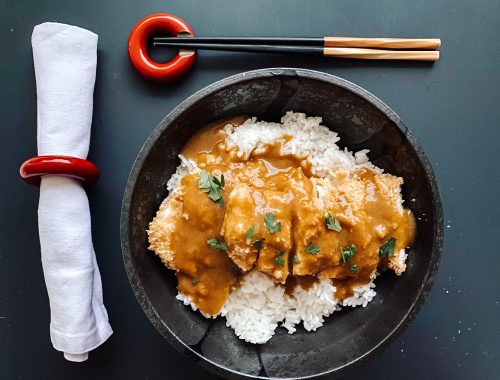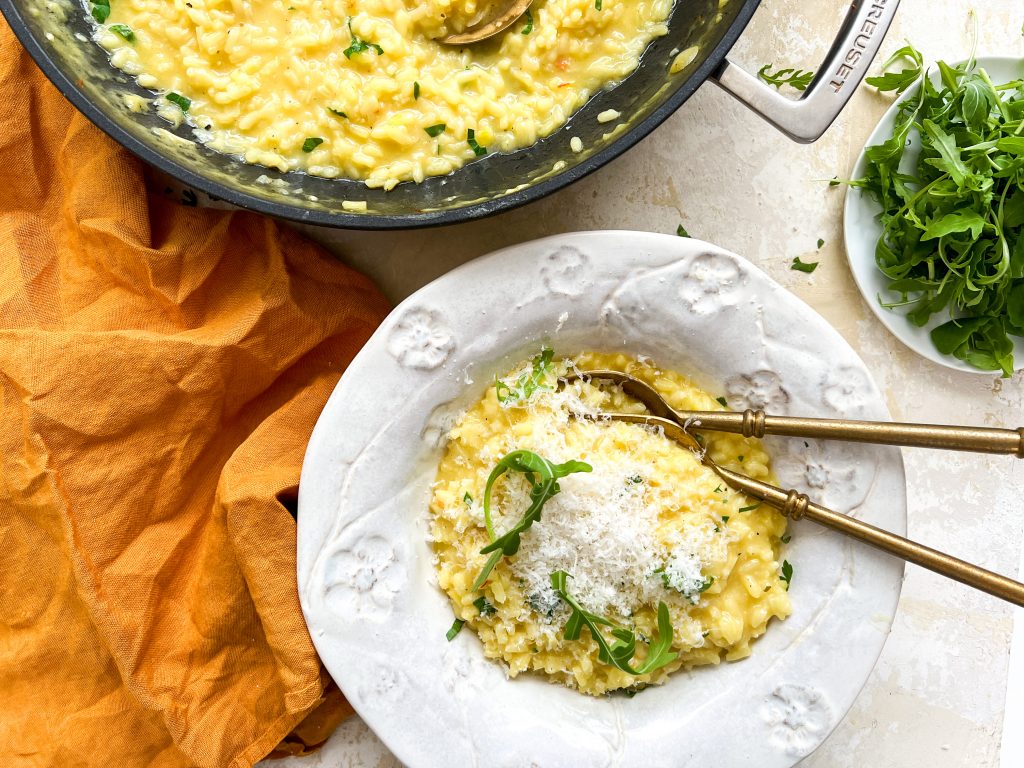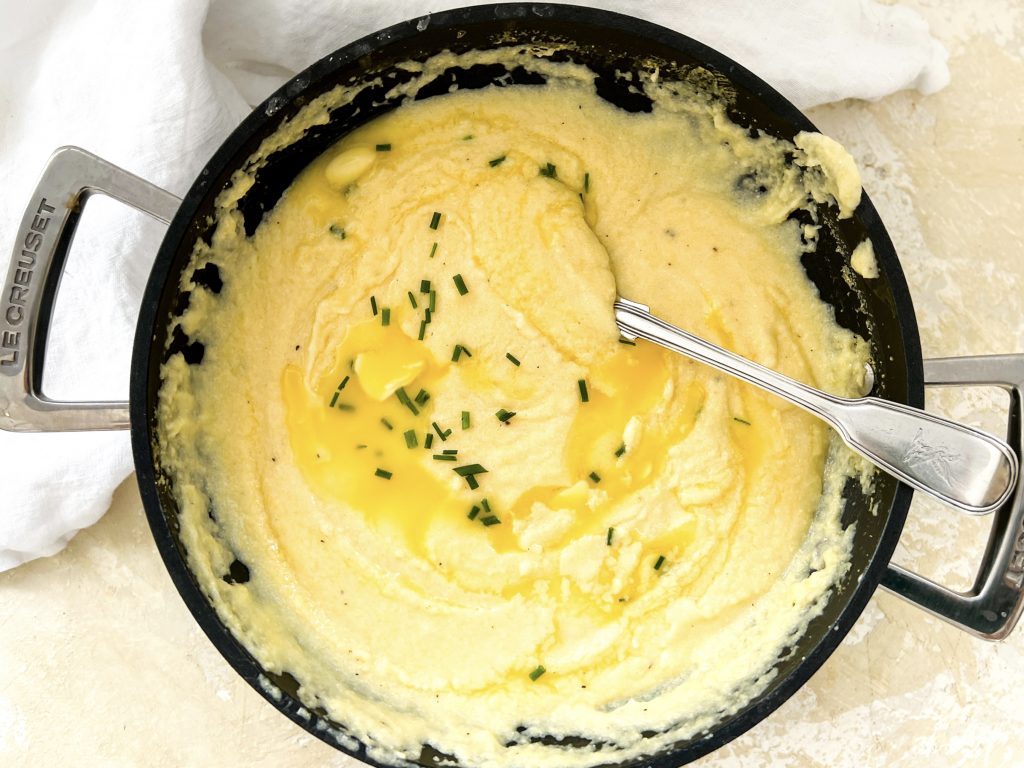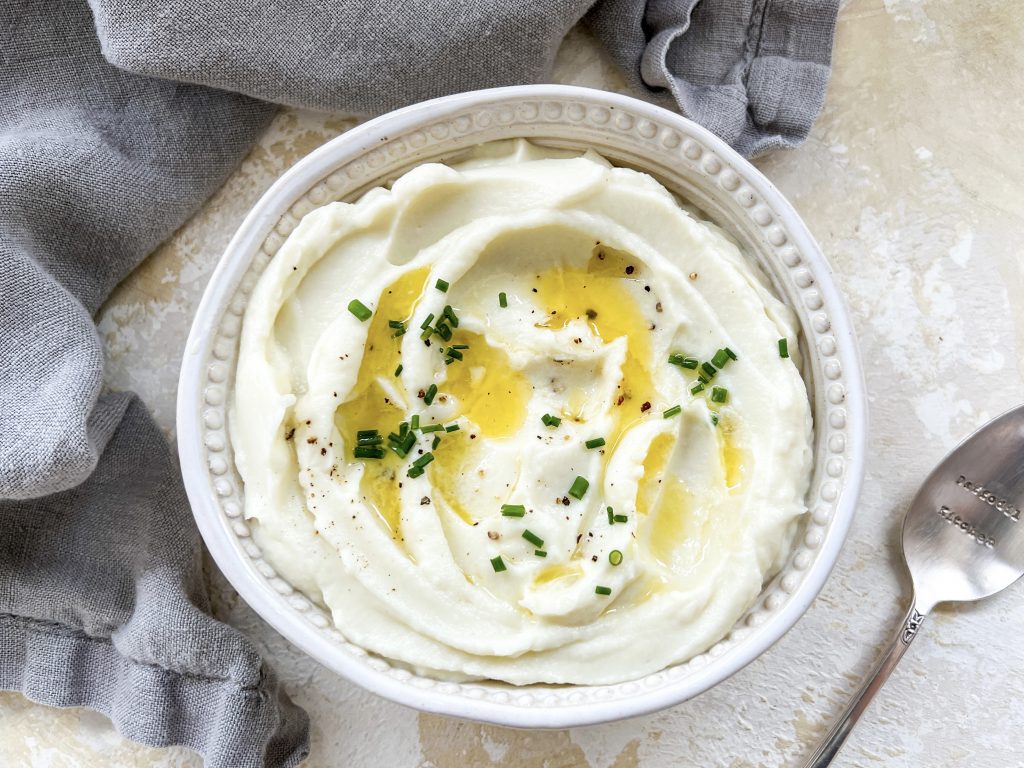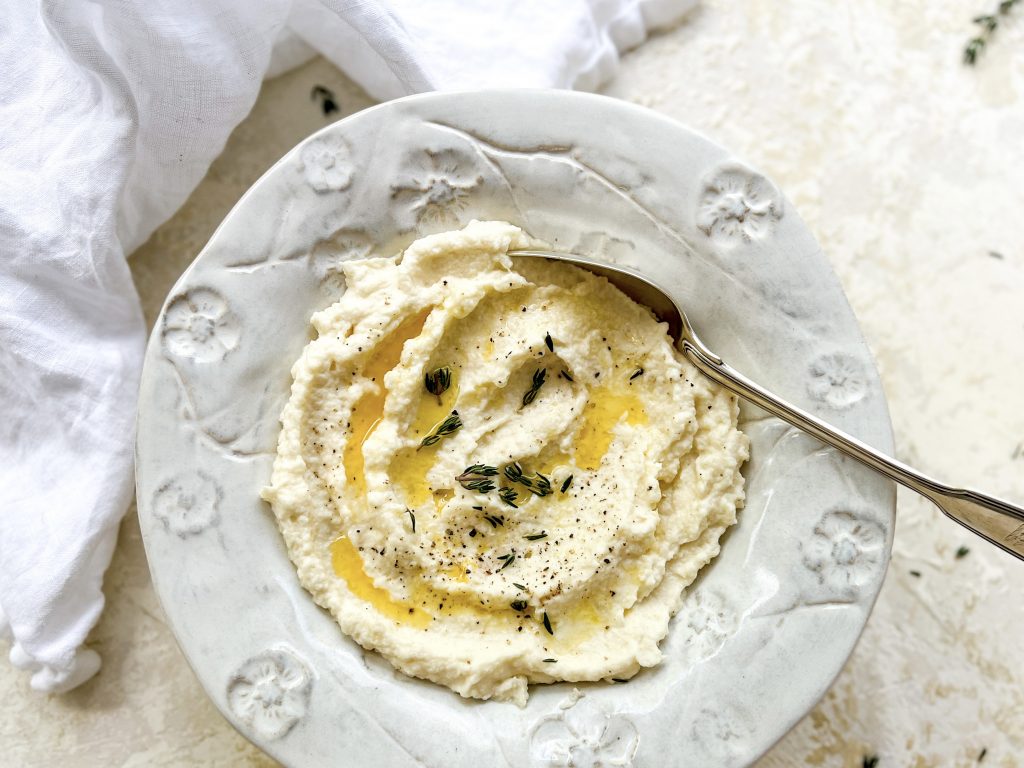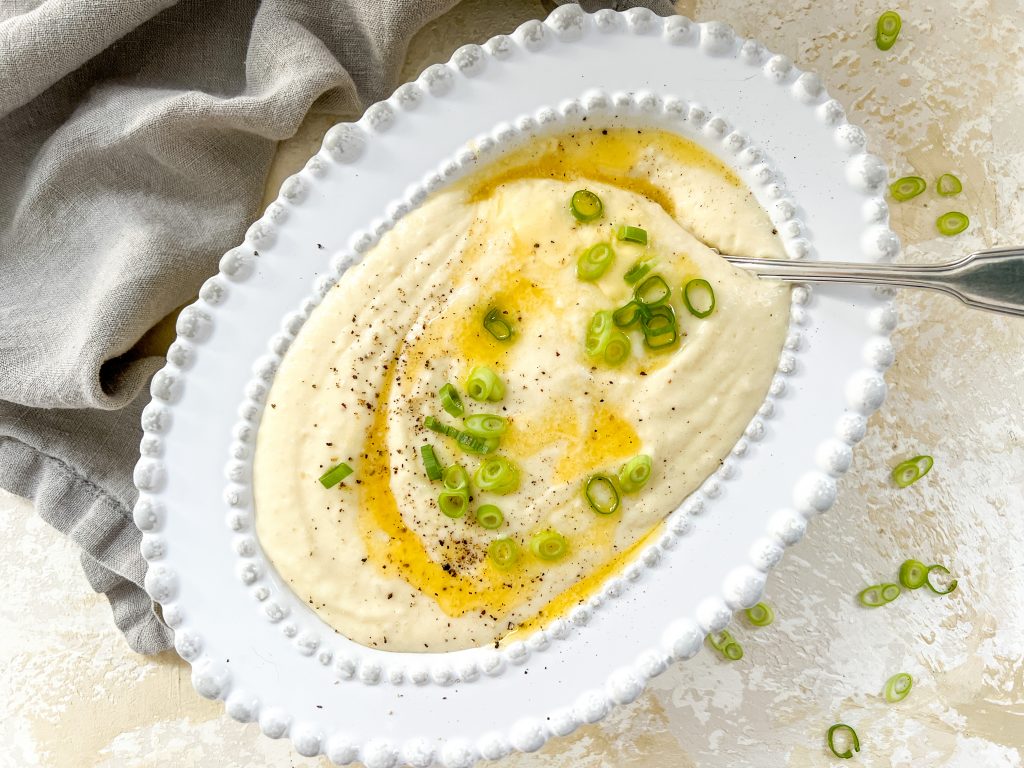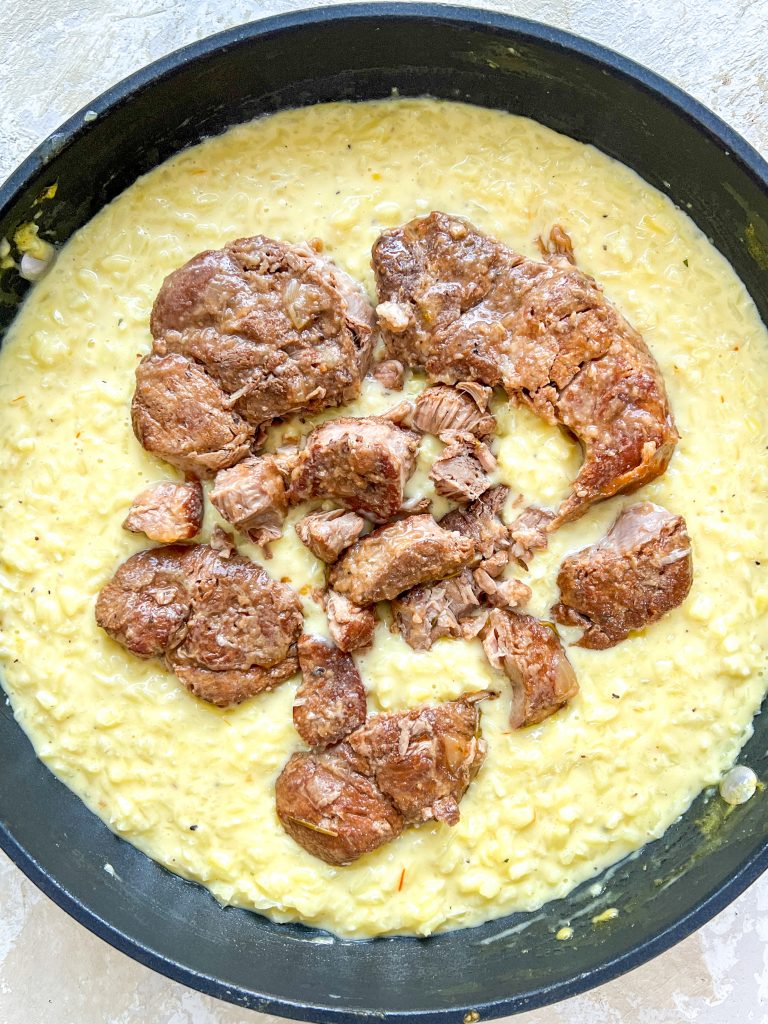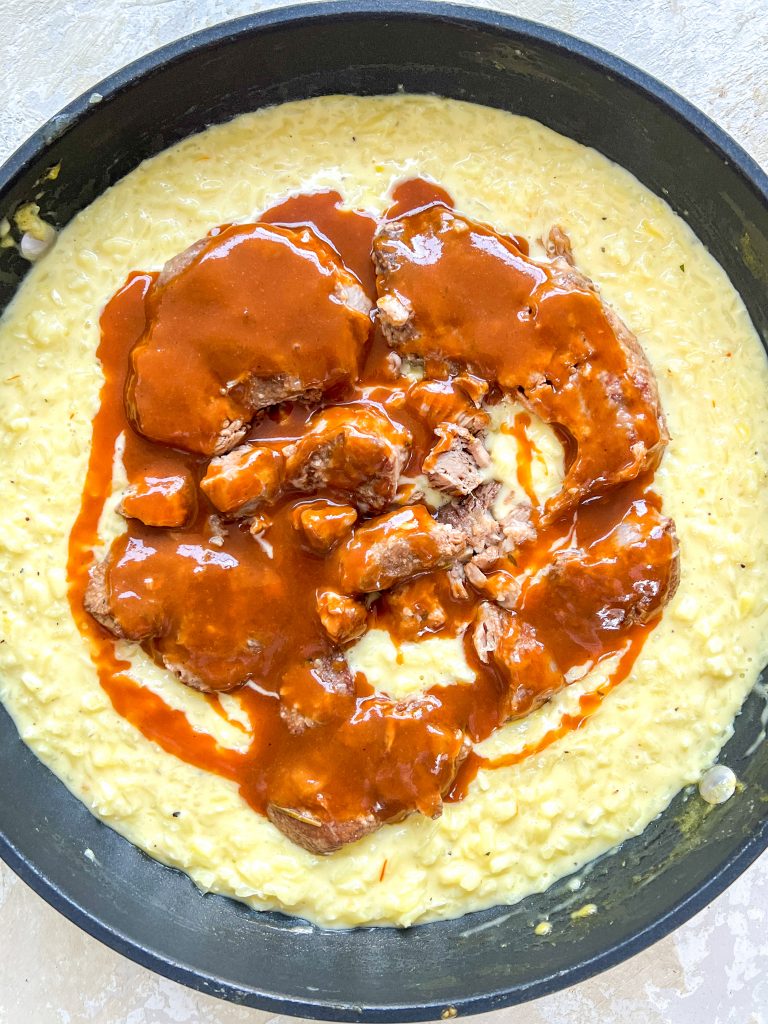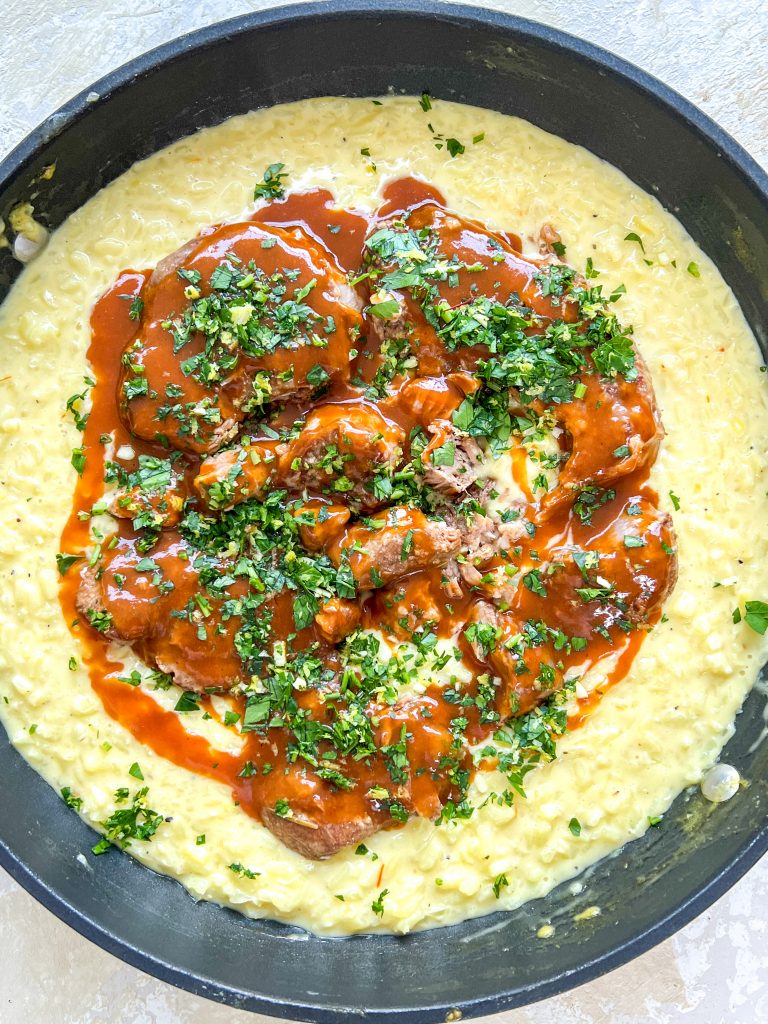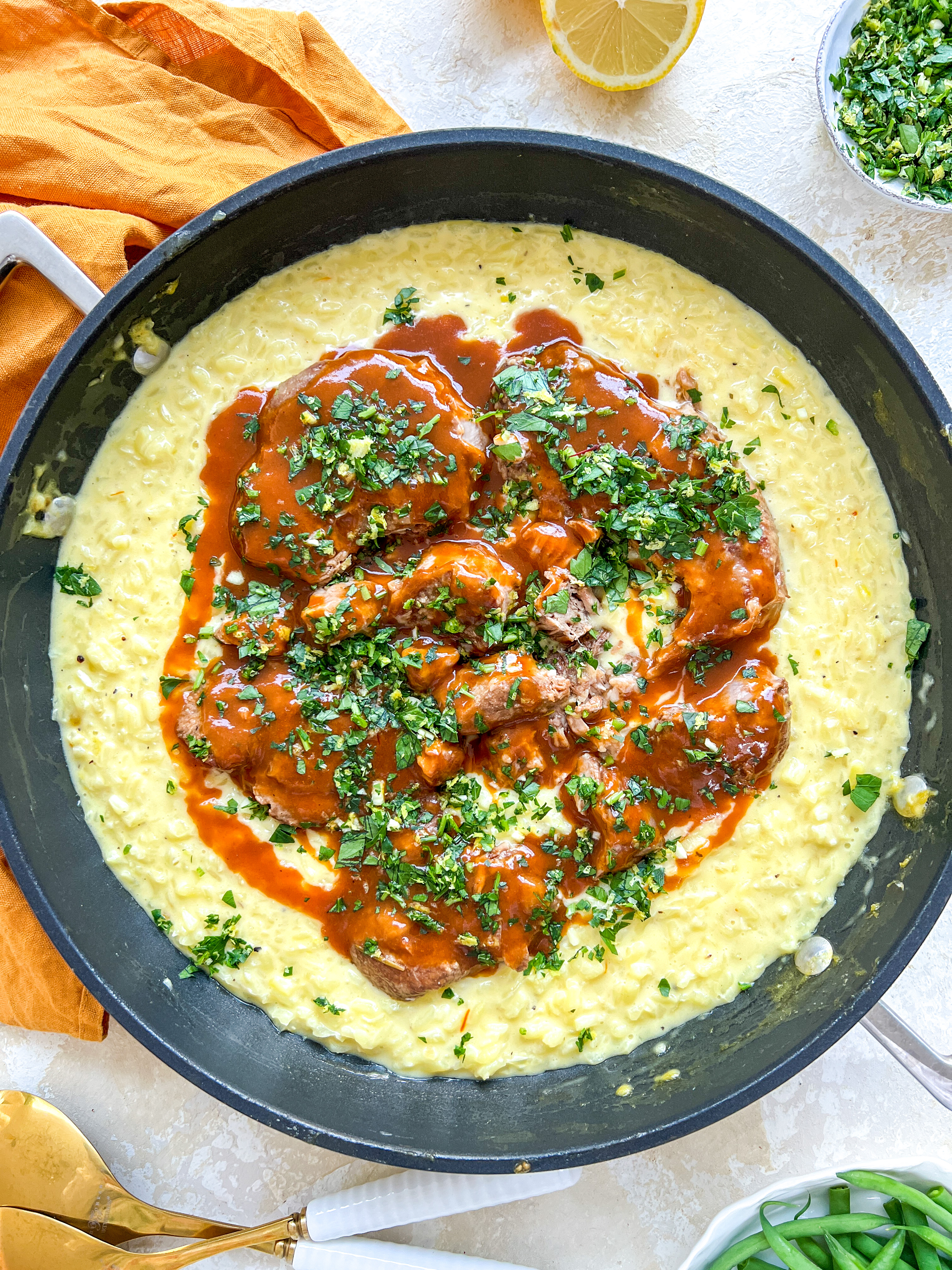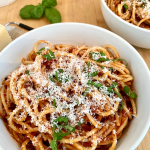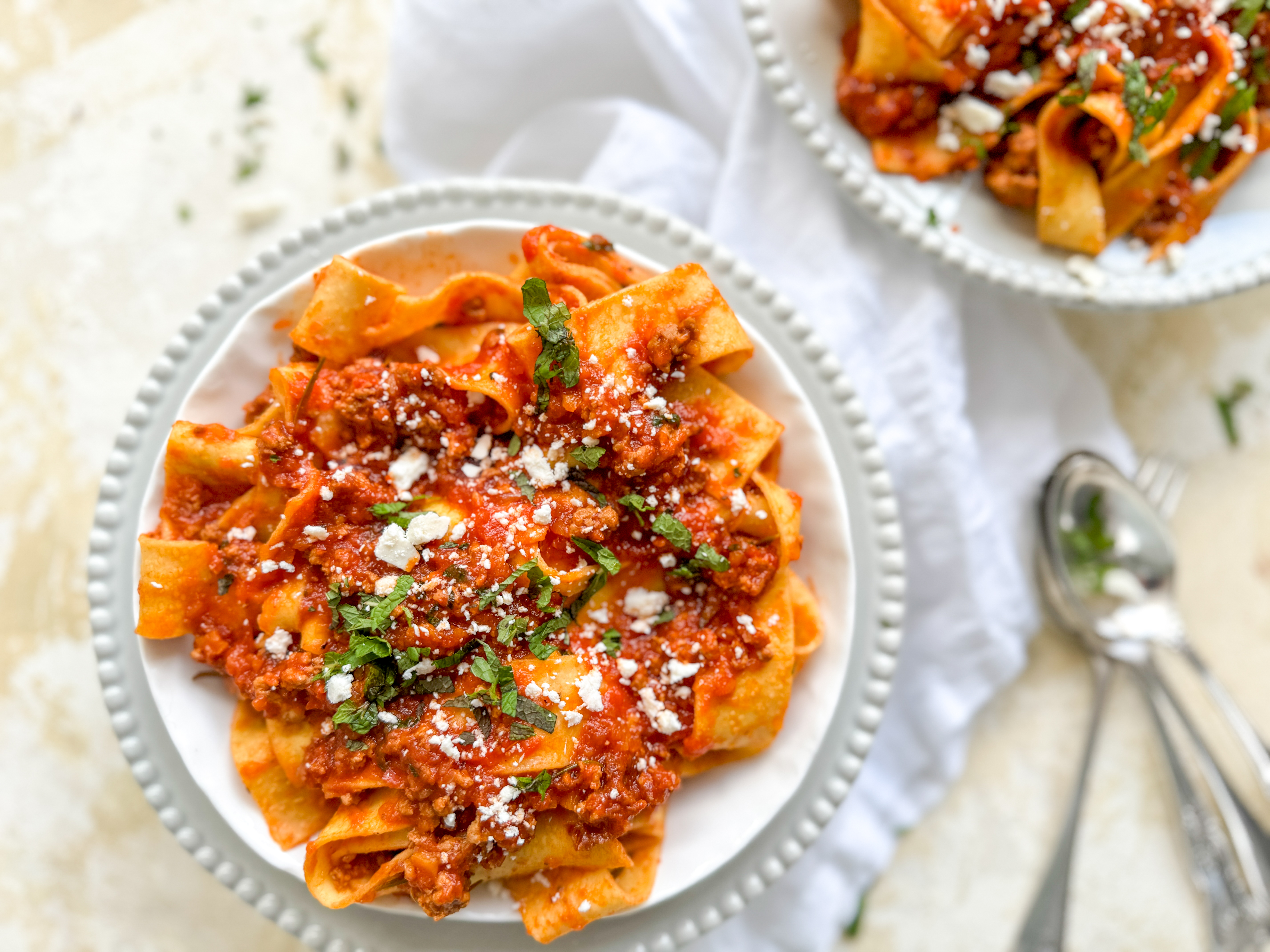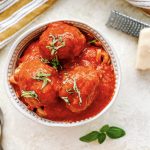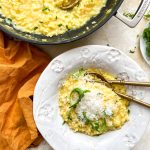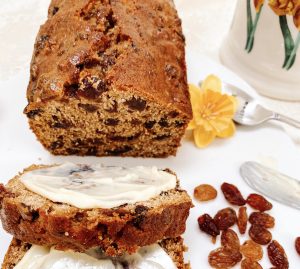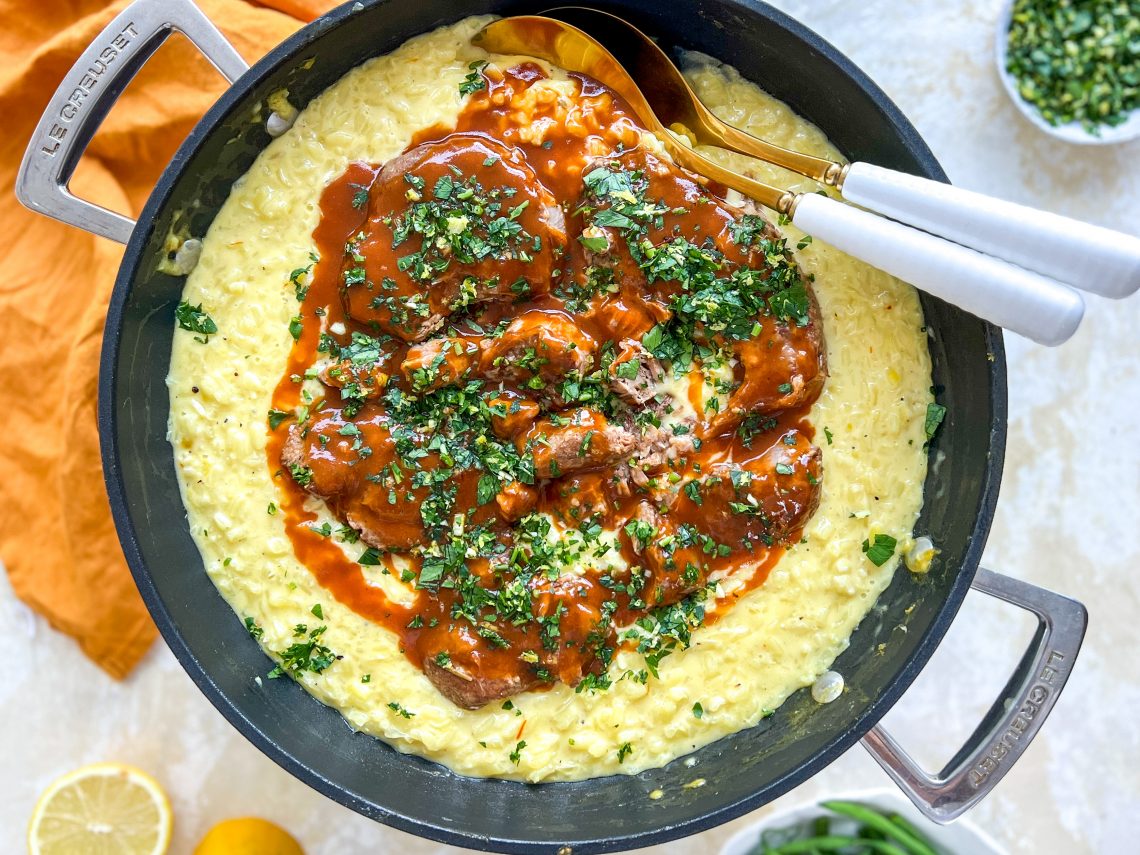
Osso Buco
At the heart and soul of Osso Buco are veal shanks, slow-braised to perfection in a rich broth infused with tomatoes and white wine. The shanks are cut on the bone from the veal’s shin. The marrow, cradled in this bone, is released into the stew during the slow-cooking process, imparting a deep, hearty flavour which helps define this traditional Northern Italian masterpiece. The resulting dish is indulgent, with fall-off-the-bone meat and a decadent sauce. To elevate this wonderful meal even further, Osso Buco is finished with a vibrant and zesty gremolata, adding a burst of freshness which beautifully balances the dish’s richness.
Osso Buco, literally translated as ‘off the bone’, has delighted the palates of generations of Italians and is a celebration and embodiment of hearty, tender, classical, luxurious, comfort food.
How classic is this Osso Buco recipe?
Like all traditional dishes, there is no single recipe. Occo Buco varies area to area and family to family. My version is based on a range of recipes I have tried and adjusted to suit our palate. Whilst I hope it stays true to the classic Milanese dish, cooking the meat on the bone but serving it off the bone, and straining the sauce, are the two most obvious divergences from most recipes. Happily, these are two changes you can easily ignore; however, if you choose not to strain your sauce, you will still need to reduce the liquid and don’t forget to remove the cooked herbs and garlic halves.
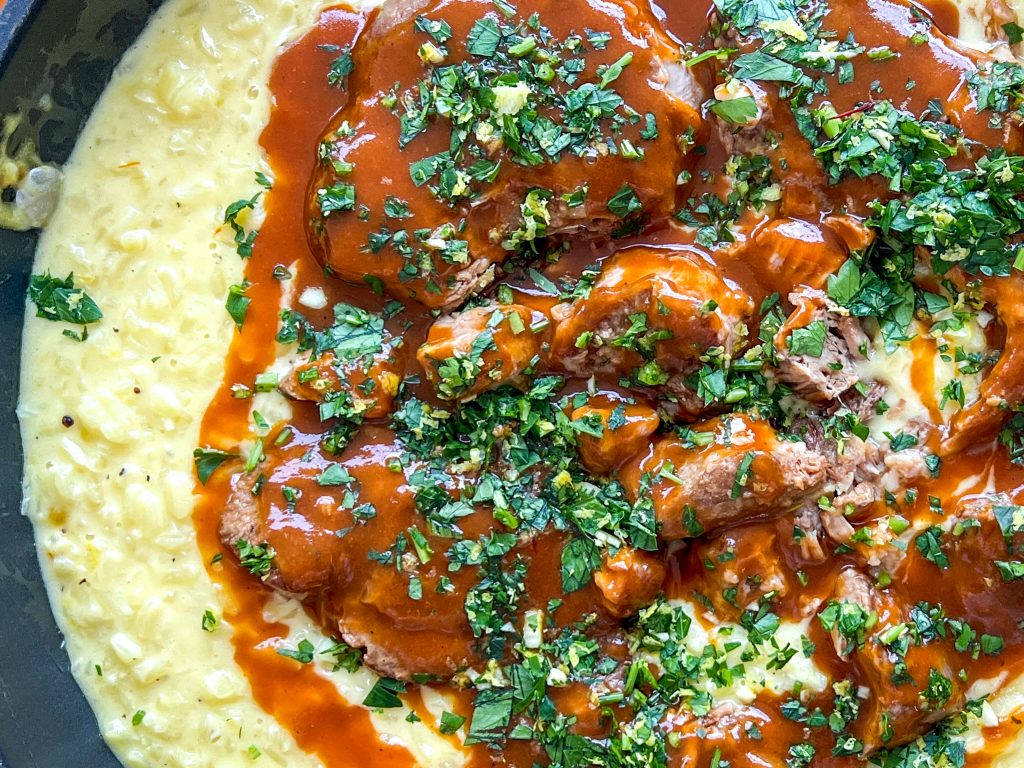
What should I serve with Osso Buco?
For a truly classical experience, Osso Buco is served with a side of Risotto alla Milanese, a golden-hued, saffron infused rice dish that perfectly complements this dreamy stew. Creamy Polenta is another classic accompaniment and mashed potatoes are also a fabulous match. If you are looking for lighter options, try Cauliflower Purée, Celeriac Purée or a Celeriac and Potato Purée
How to make Osso Buco
Collect all your ingredients together:
Meat:
- veal shanks, trimmed and tied
- plain/all-purpose flour
- fine salt
- freshly ground black pepper
- olive oil
Sauce:
- olive oil
- onions, diced into 1 – 1½ cm cubes
- carrots, diced into 1 – 1½ cm cubes
- celery, diced into 1 – 1½ cm cubes
- bulbs of garlic, halved horizontally
- dry white wine
- plain/all-purpose flour
- fine salt
- freshly ground black pepper
- chicken stock
- tomato paste
- fresh rosemary
- fresh thyme
- leaves
- whole cloves
Gremolata:
- flat-leaf Italian parsley
- lemon zest
- garlic
Serve:
- gremolata
- Risotto alla Milanese/mashed potatoes/Creamy Polenta/pasta. If you are looking for lighter options, try Cauliflower Purée, Celeriac Purée or a Celeriac and Potato Purée
- green salad or vegetables such as green beans or roast Mediterranean vegetables
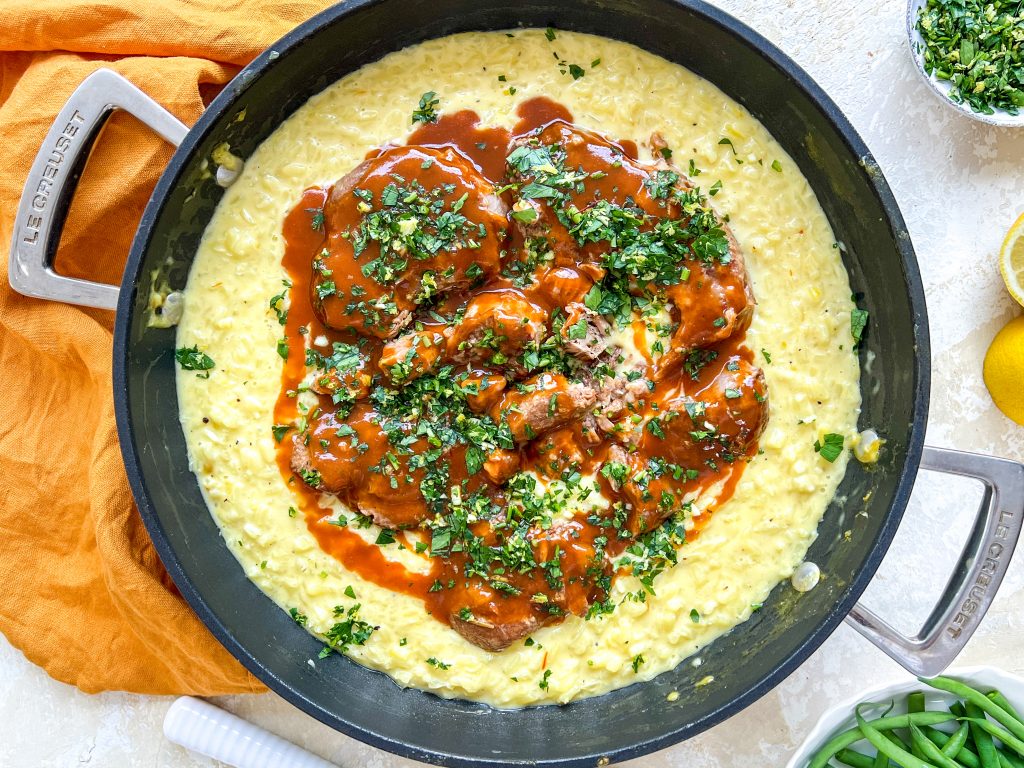
Start with the Meat:
- Measure the flour onto a mixing plate and season well with salt and freshly ground black pepper. Stir well to mix.
- Dredge the veal in flour on both sides.
- Put 1 – 2 tablespoons oil in your casserole over a moderately high heat. When the oil is hot, shake excess flour off the veal, put 1 or 2 shanks into the pan and brown on both sides. Do not overcrowd the pan; cook them individually, if necessary. They take around 3 minutes per side. Repeat with the remaining veal, adding more oil as required.
- Remove from the pan and cover with foil.
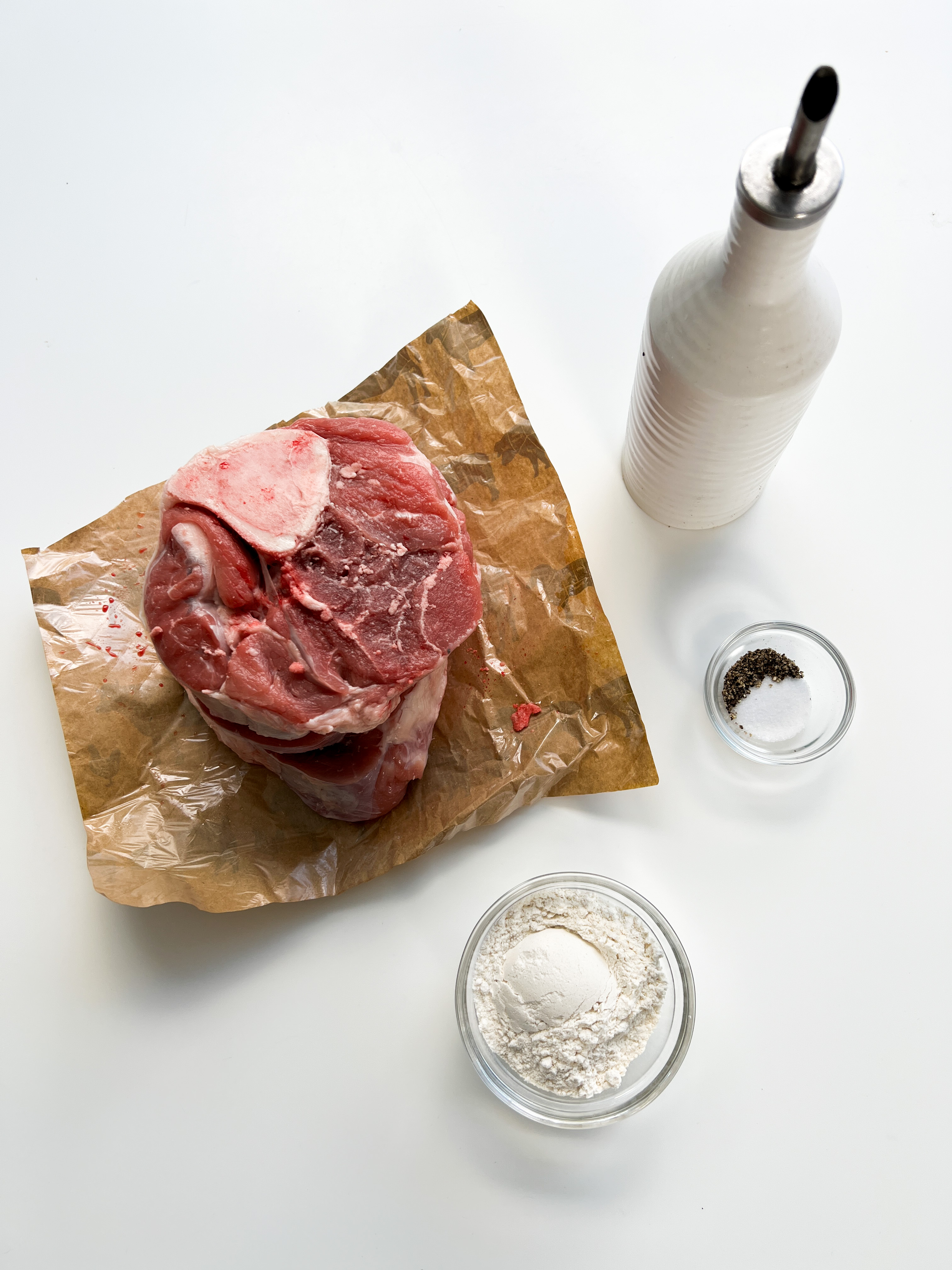
Meat ingredients 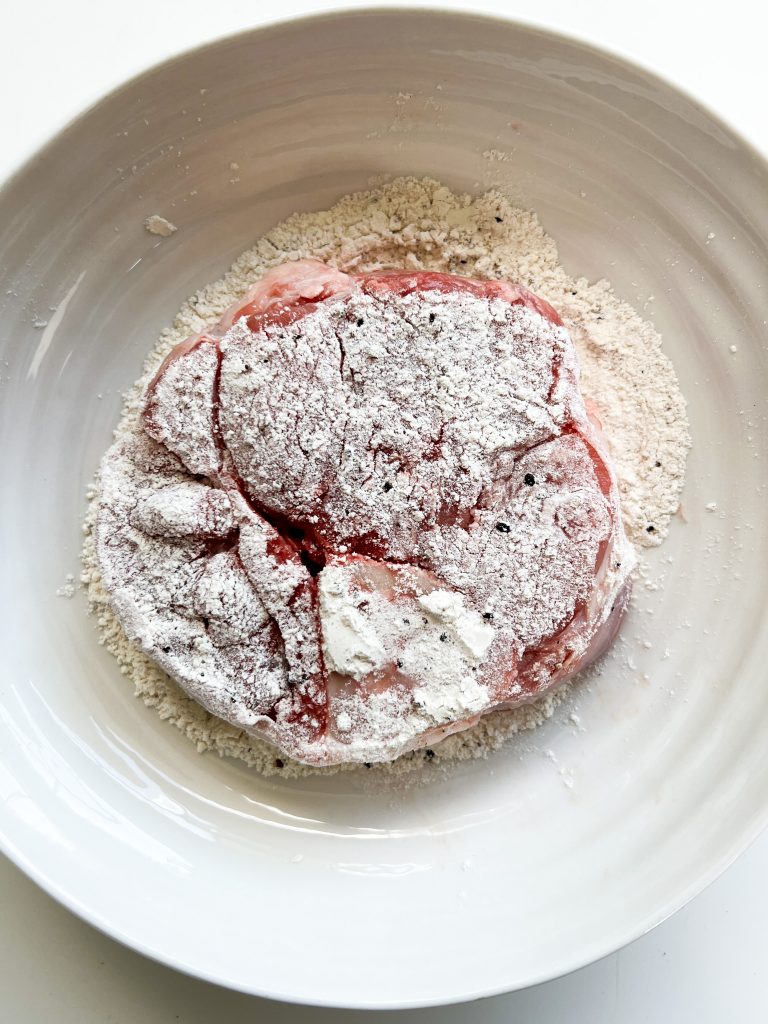
1, 2 Flour meat 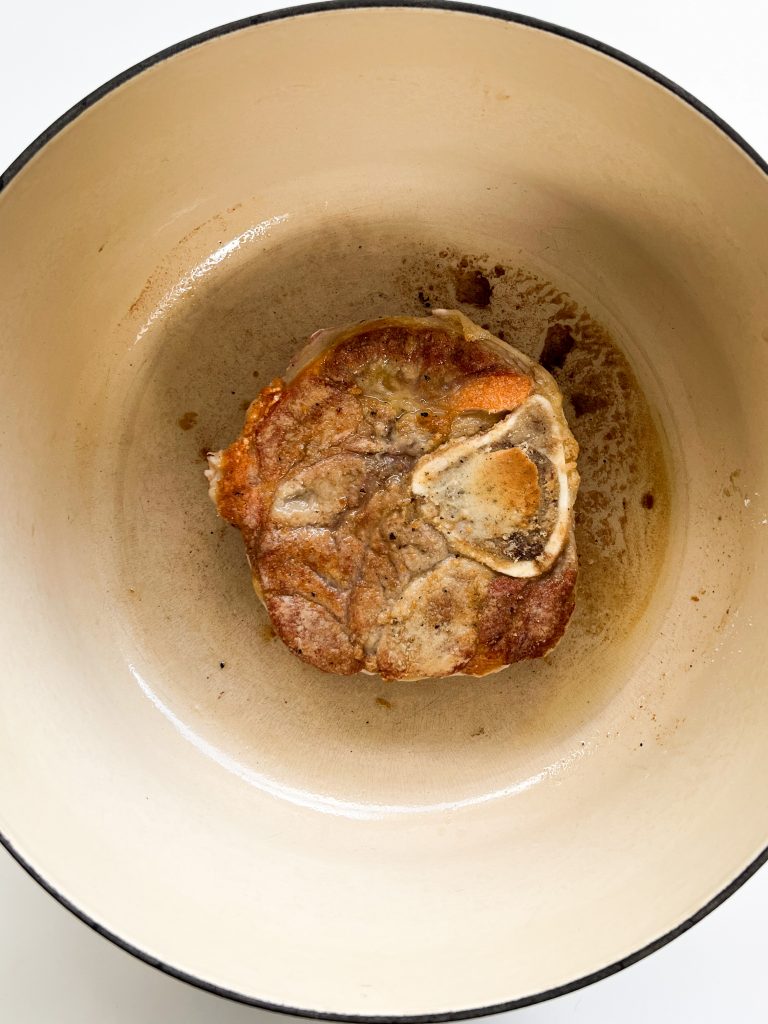
3 Cook
Next the Sauce:
NB You can cook this on the hob or in the oven. Your choice.
- If cooking in the oven, preheat to 150°C/300°F/Gas 2 (fan 130°C).
- Discard the oil and wipe out pan to remove any burnt flour. Add a further 1 tablespoon of oil, over a moderate heat. When the oil is hot, add the onion, carrot and celery (soffritto) and cook for 10 minutes, stirring from time to time, until soft and slightly caramelised.
- Add the garlic and continue to cook for a further 2 minutes.
- Now add the wine and cook until it has reduced and almost disappeared.
- Add the flour, salt and pepper and stir well. Cook for 2 minutes. NB Do not add any more salt and pepper at this stage. When you reduce the sauce later, taste it and adjust the seasoning then, if necessary.
- Add the stock, tomato paste, rosemary, thyme, bay leaf and cloves and bring to a gentle boil, stirring all the time.
- Turn down to a simmer and add the veal back to the pan. Make sure the veal is covered by the sauce, or at the very least, ¾ of the way up the side of the veal. If necessary, add extra stock. Cover and cook on very low, on the hob, for 2½ – 3 hours. Alternatively, cook in a preheated oven for the same length of time. NB Keep an eye on your stock levels. If necessary, add more stock.
- When the veal is cooked i.e. very soft and falling off the bone, remove carefully from the pan and cut off the string/twine. You can serve it on or off the bone. I prefer mine served off the bone so I remove it, as well as any fat, before I serve. The meat is so much easier to dissect when it is not covered in the glorious sauce or sinking into a bed of luxurious risotto or creamy polenta. If, however, you like to eat the bone marrow, serve it on the bone.
- Strain the sauce through a sieve into a different saucepan and return the veal to the casserole dish to keep warm.
- Bring the sauce to the boil in the saucepan and continue to cook over a high heat until the sauce and is reduced. thick and glossy. Taste the sauce and adjust seasoning, if necessary. You need around 350ml – 400ml of reduced sauce.
- Return the sauce to the casserole dish and bring back to a gentle simmer to ensure the veal is piping hot.
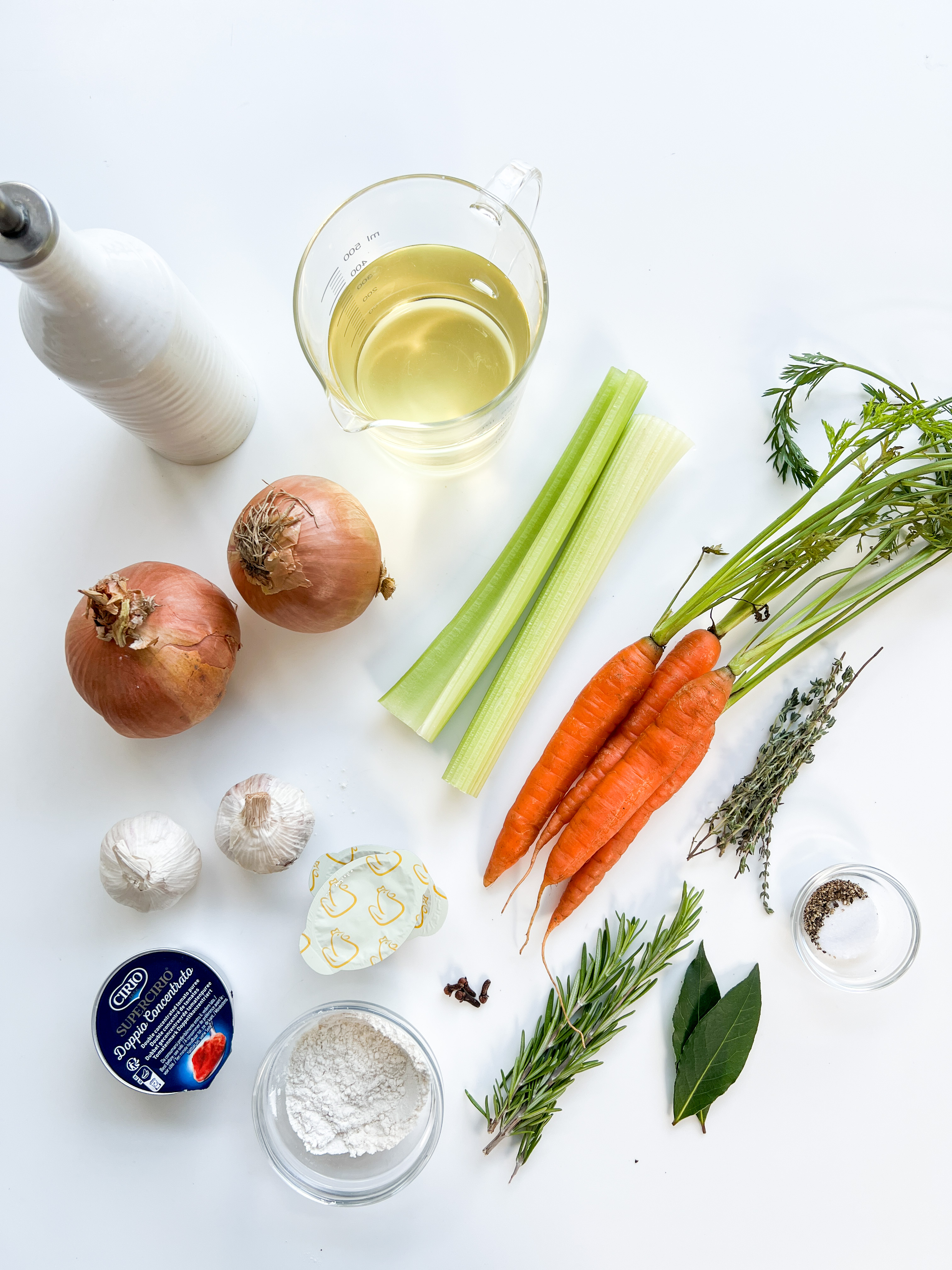
Sauce ingredients 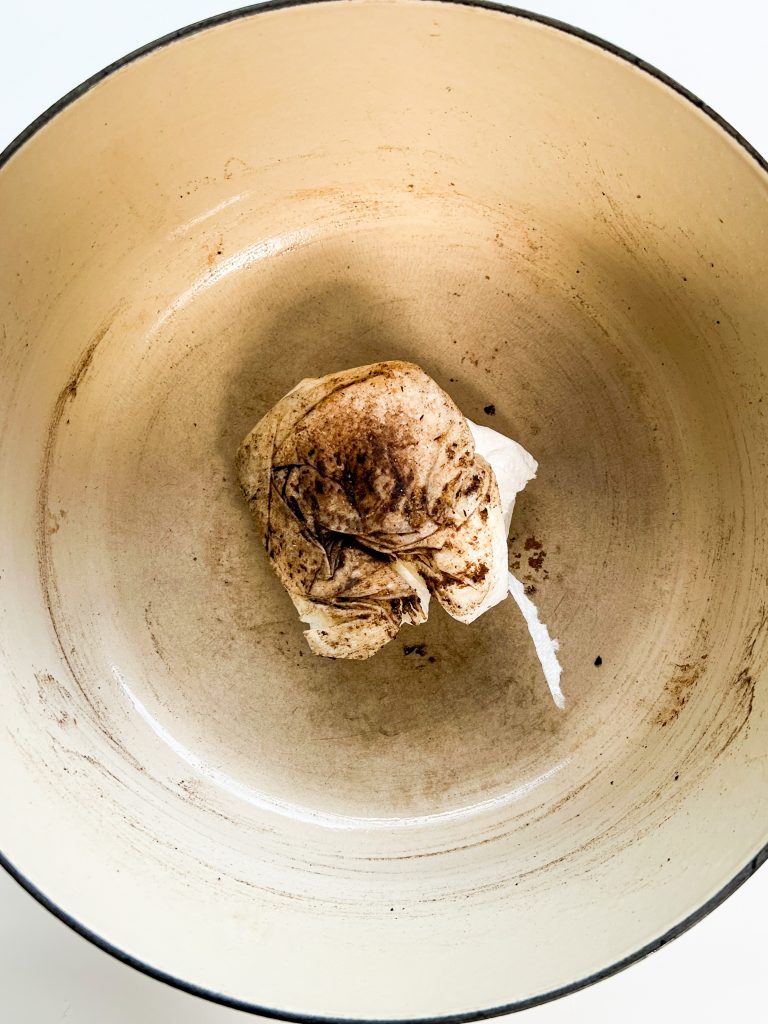
1 Clean pan 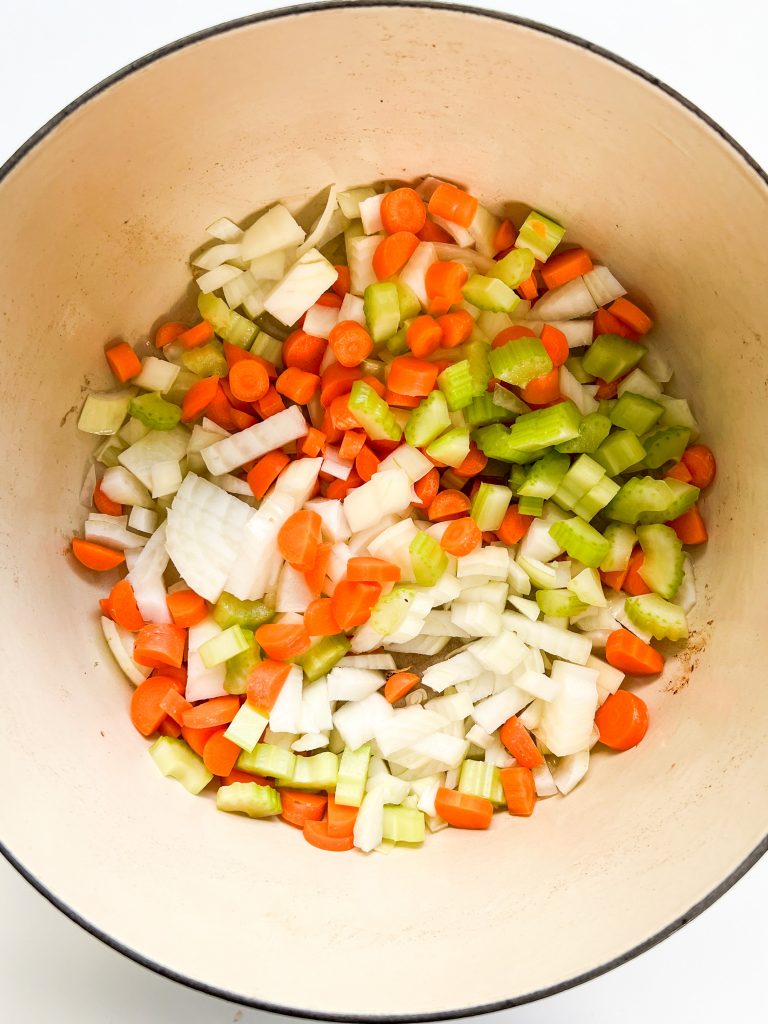
Cook soffritto 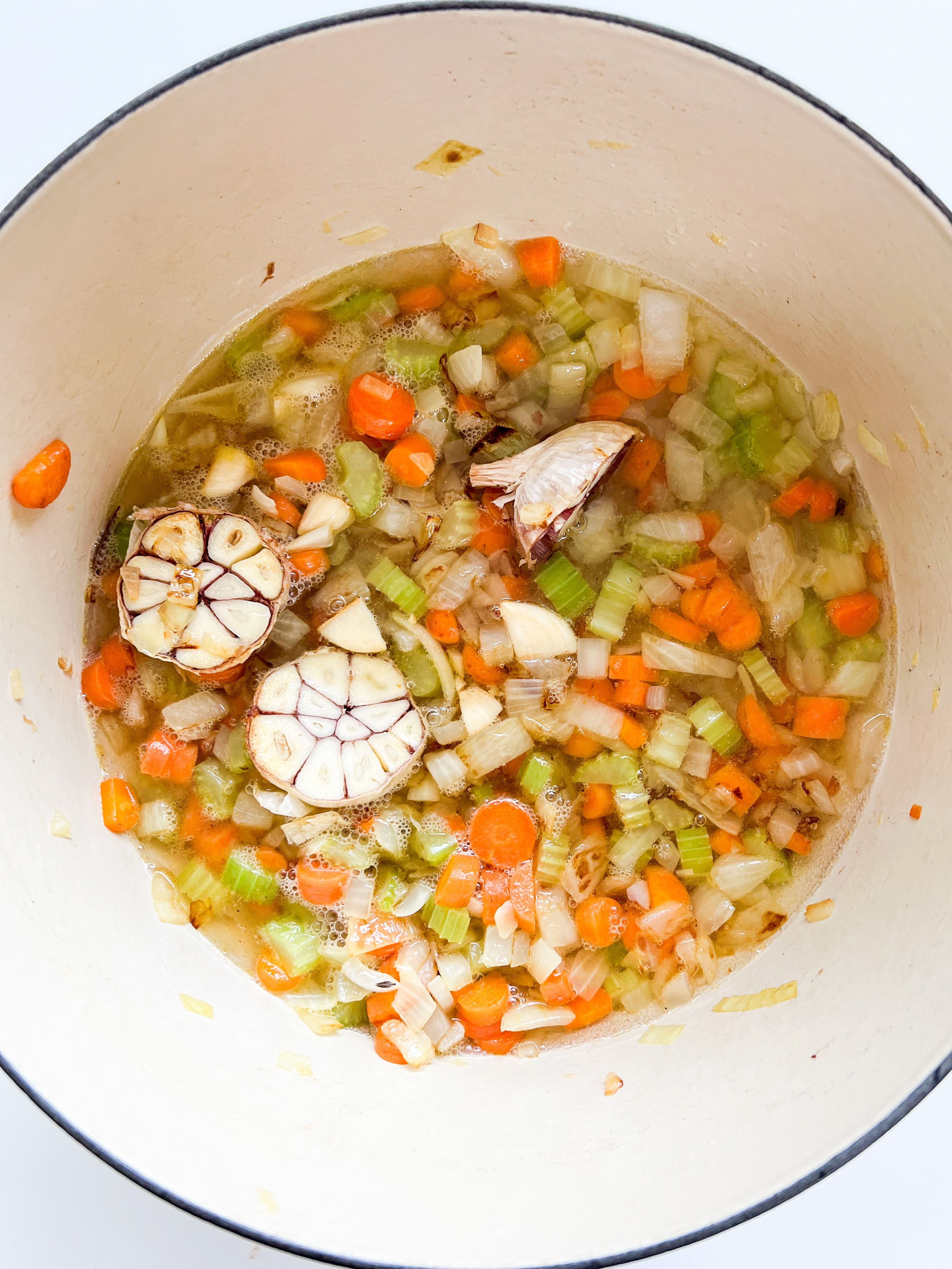
2, 3 Garlic, wine 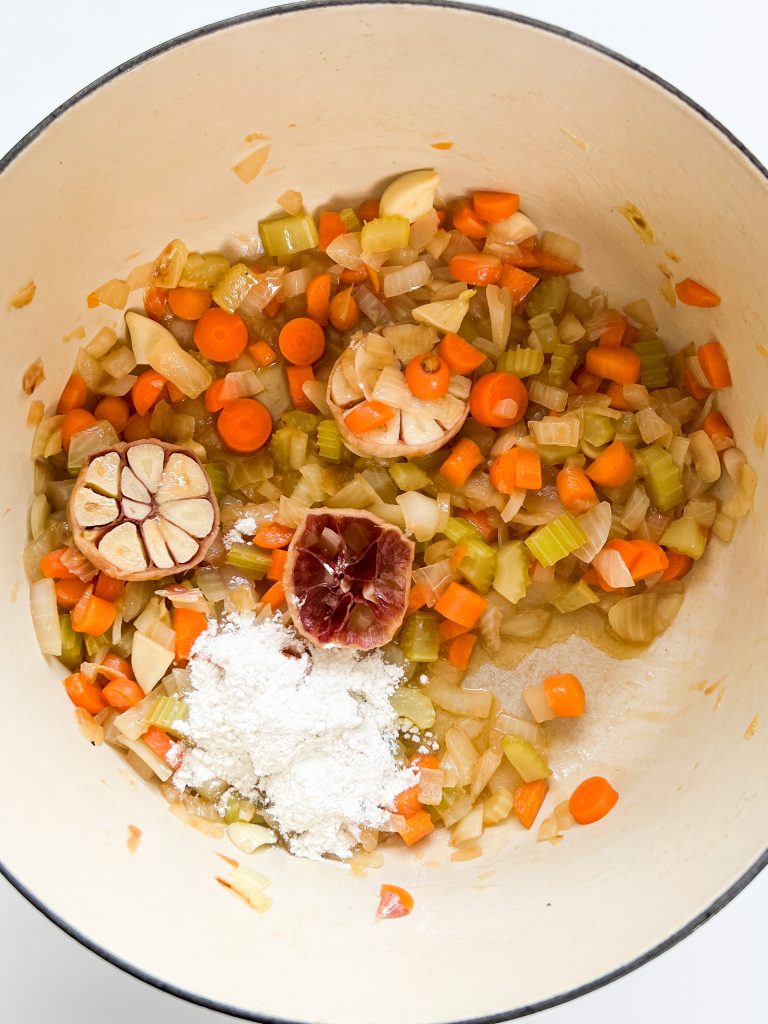
4 Flour, s&p 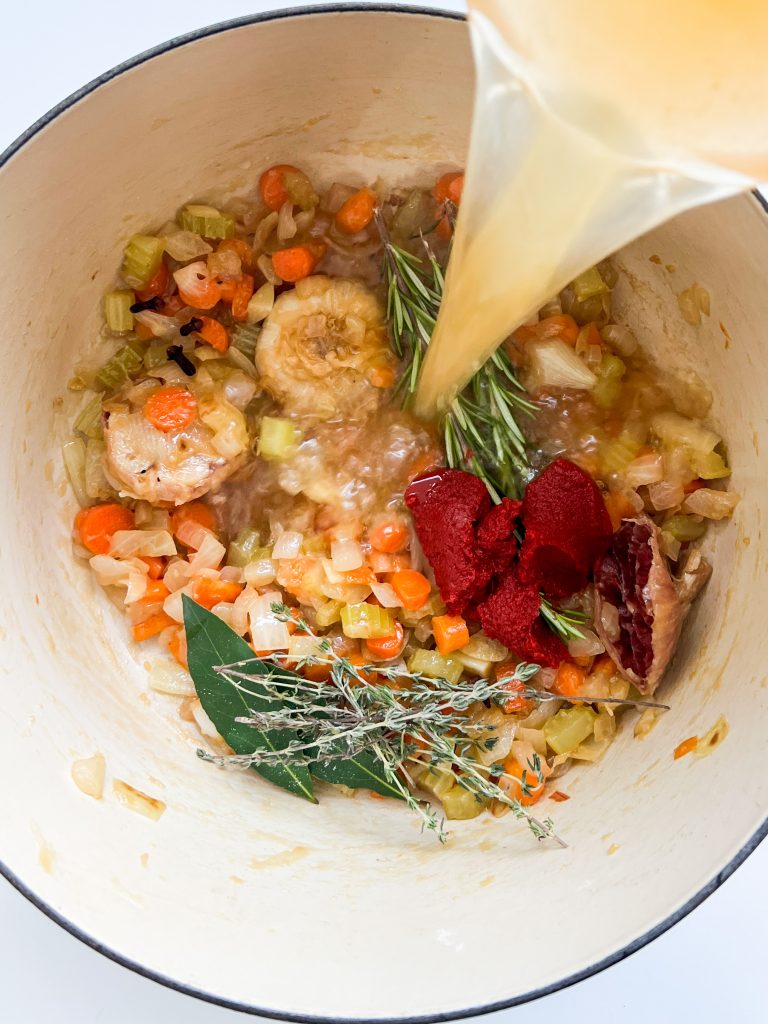
5 Stock, herbs, paste 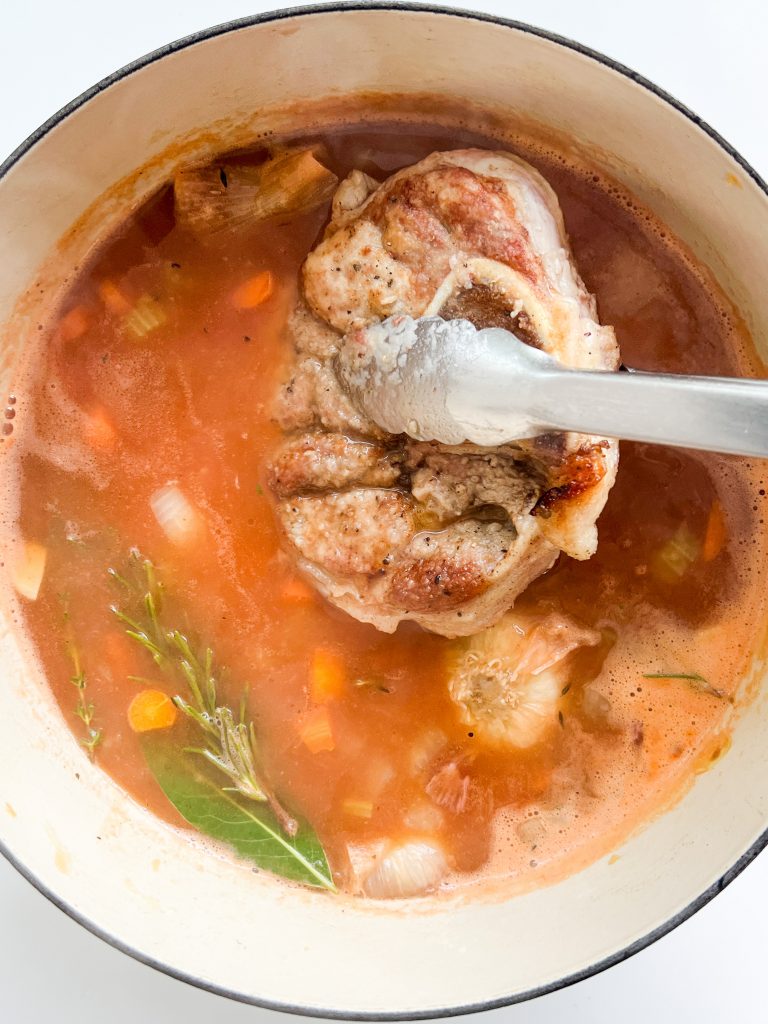
Veal 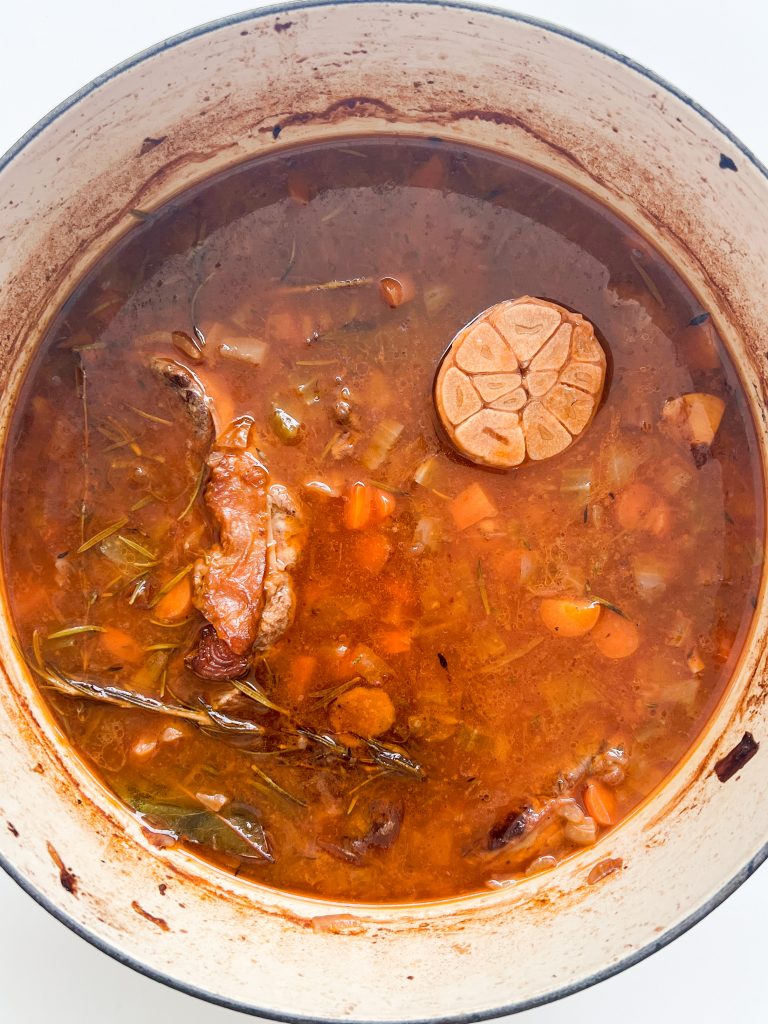
6 Cook 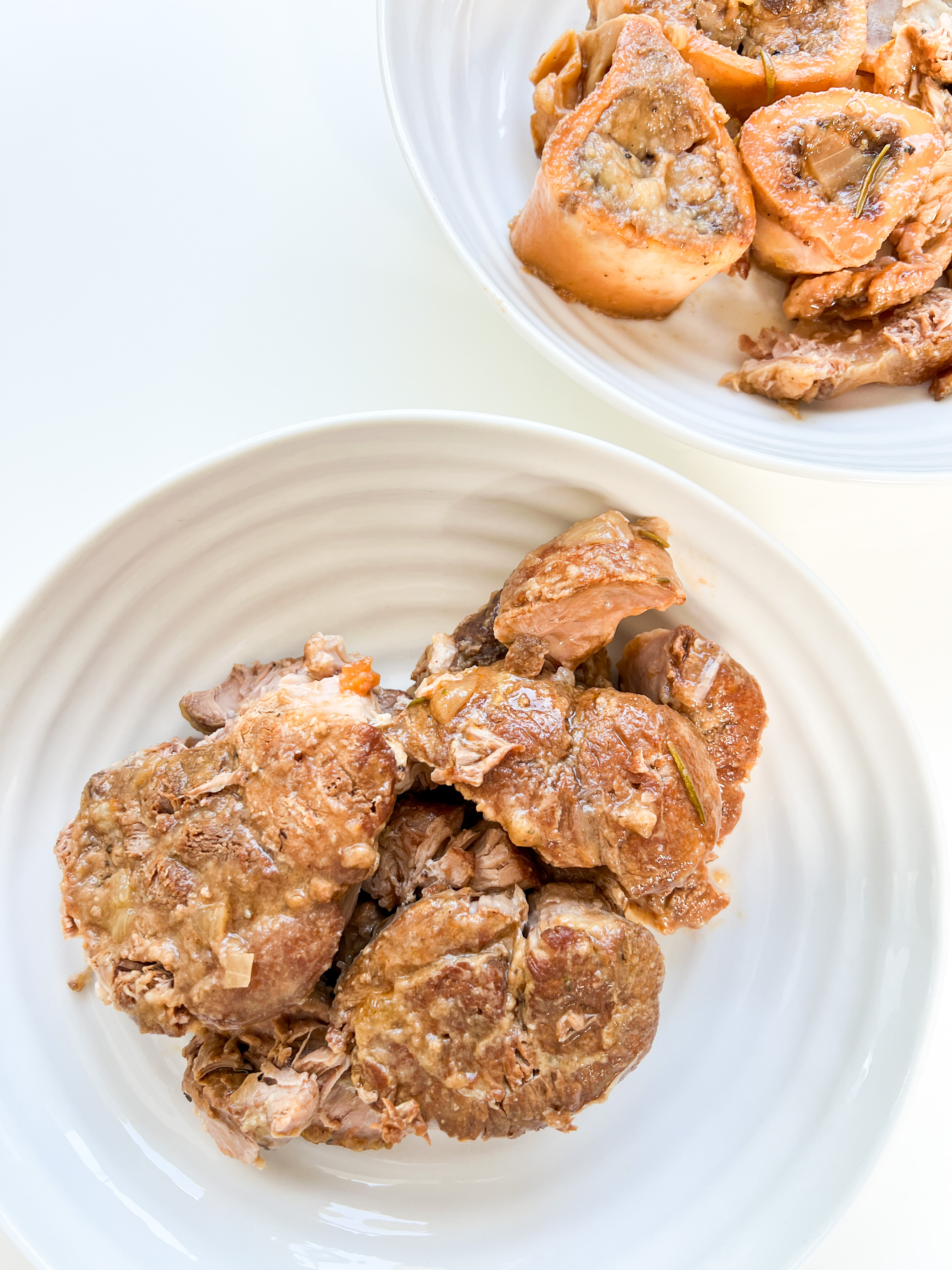
7 Veal 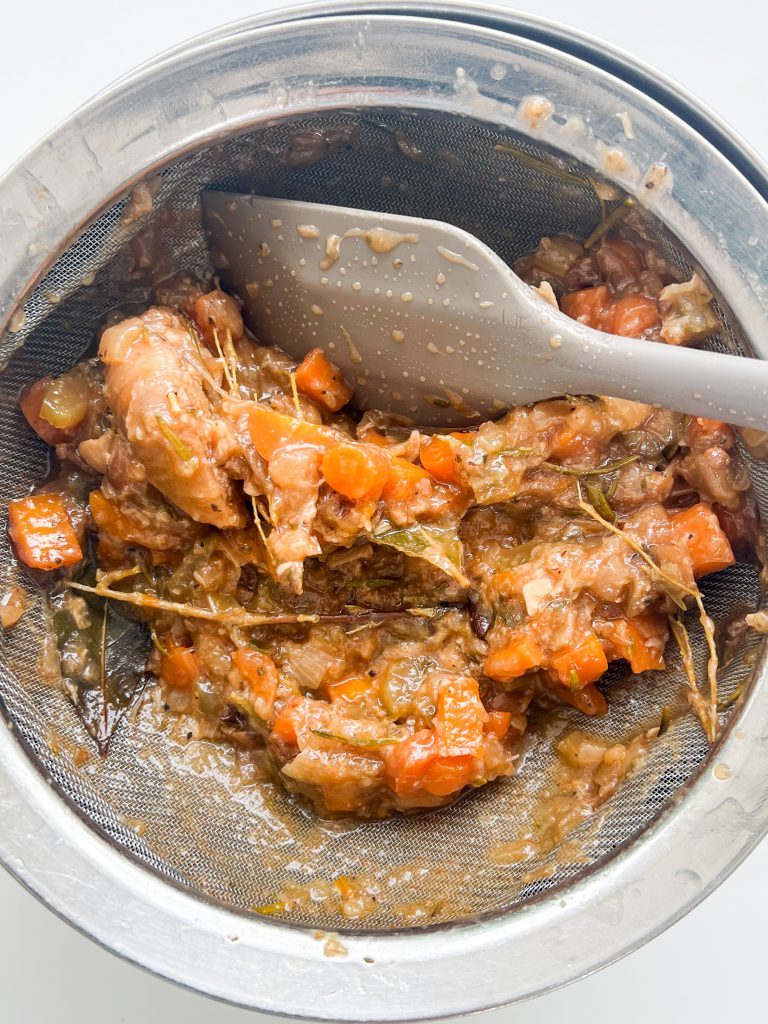
8 Strain 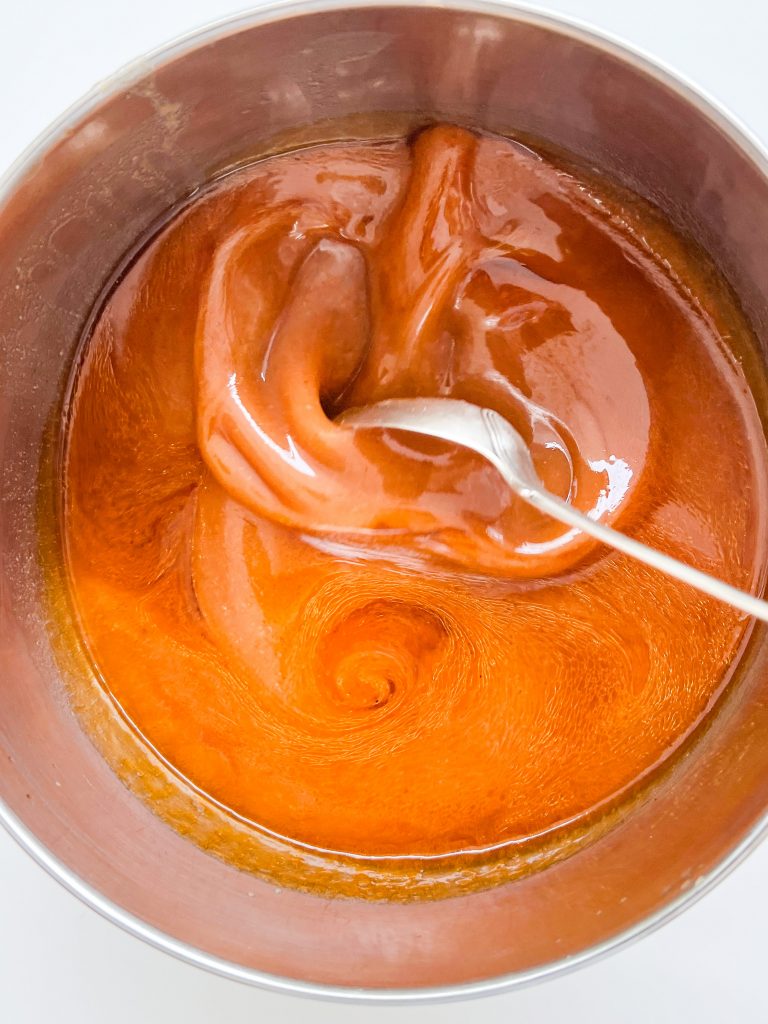
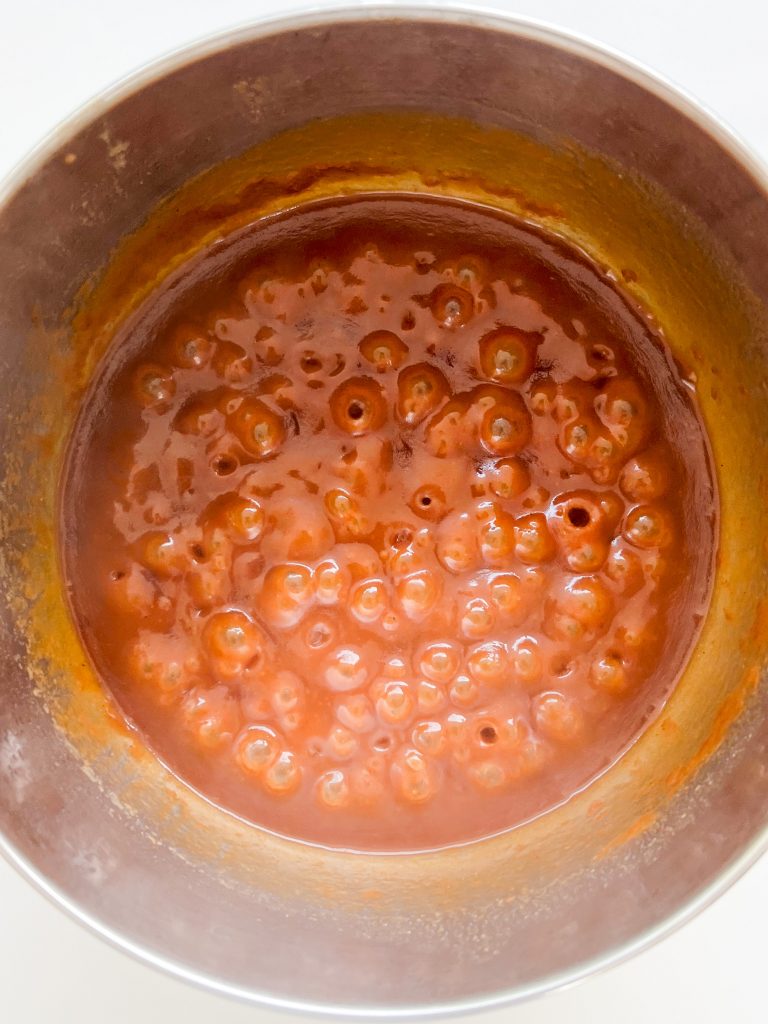
9 Reduce
The Gremolata:
- Roughly chop the parsley and garlic and grate over the lemon zest.
- Finely chop the parsley, lemon and garlic together.
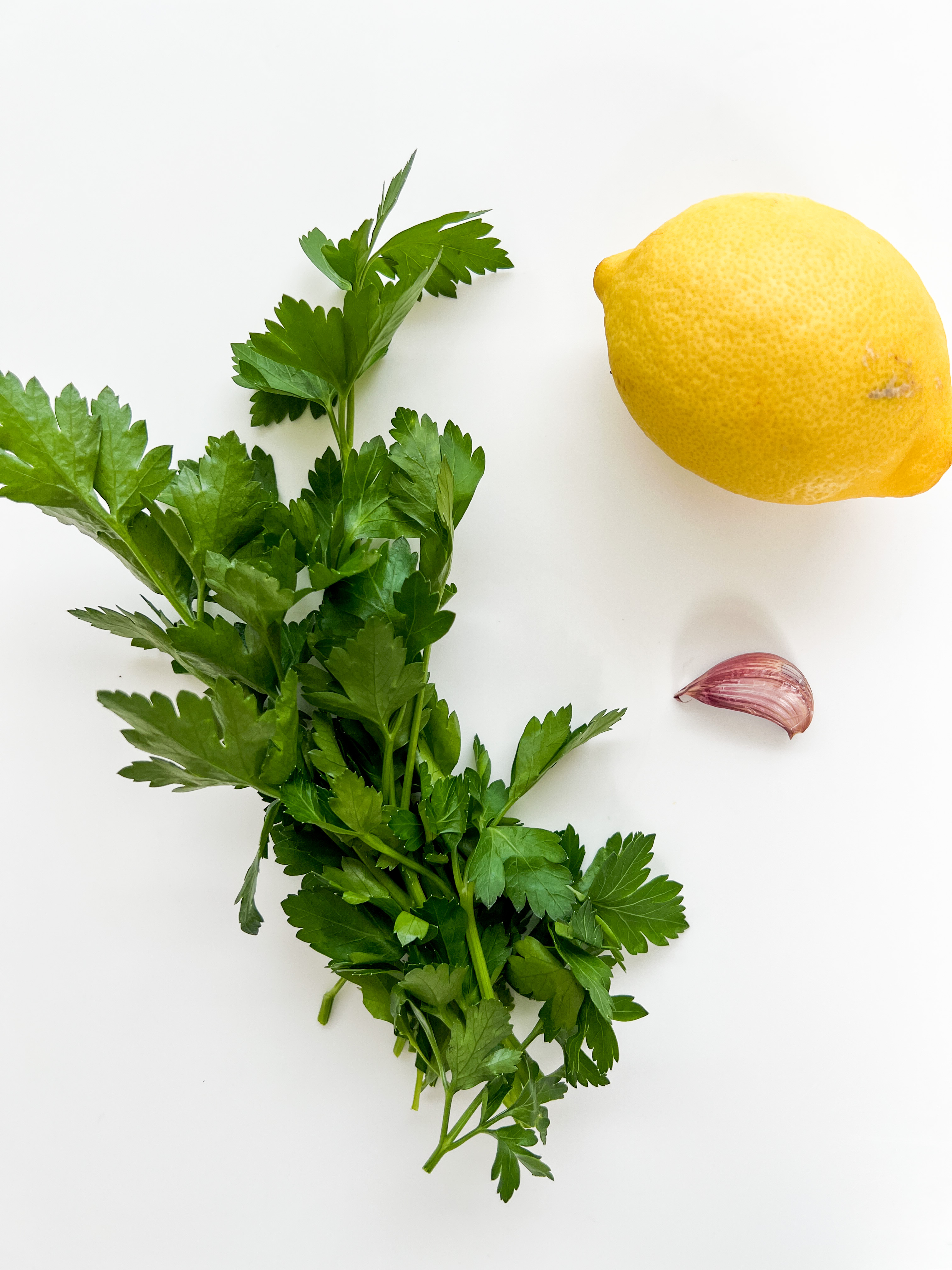
Gremolata ingredients 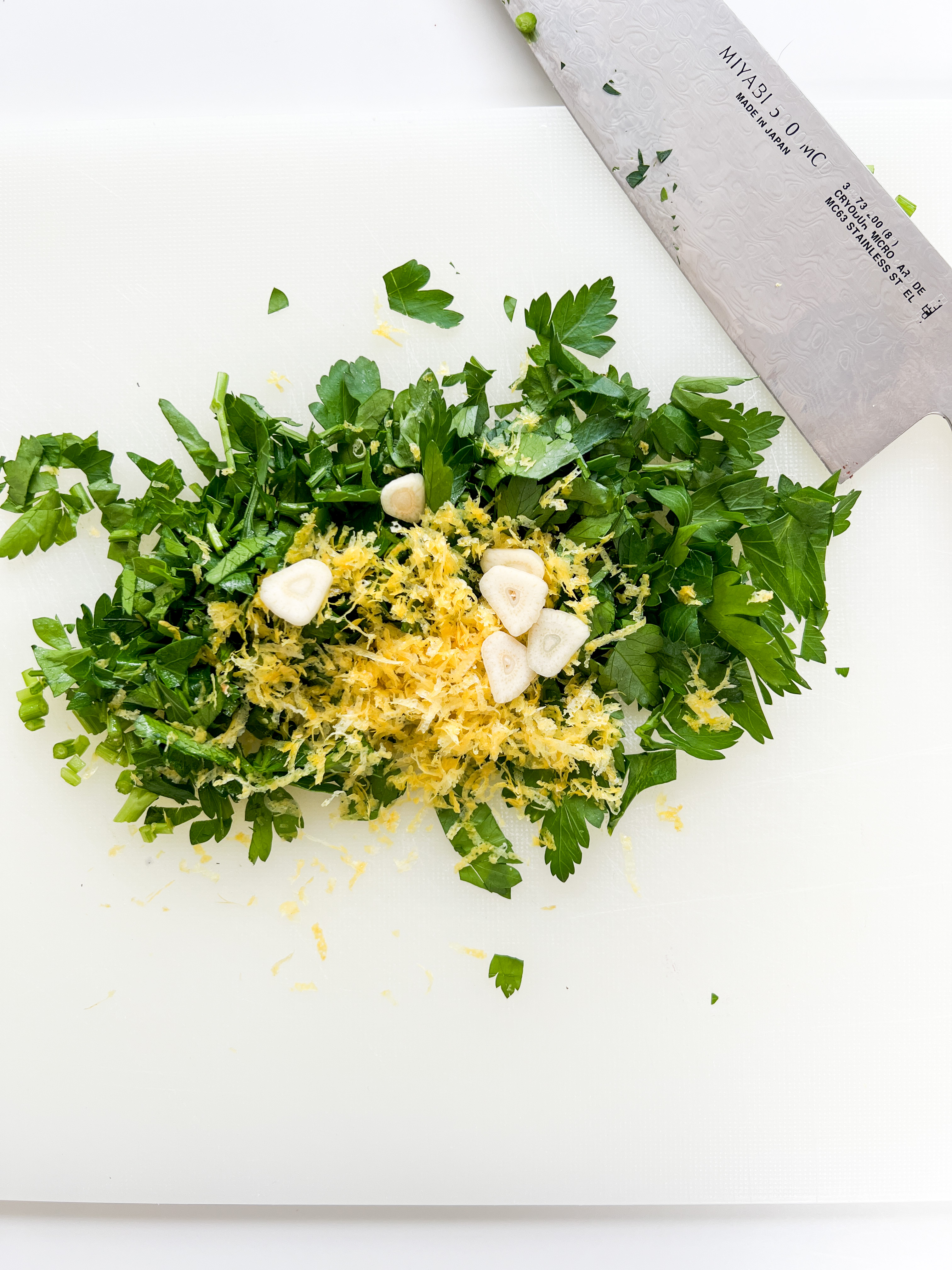
Parsley, lemon, garlic 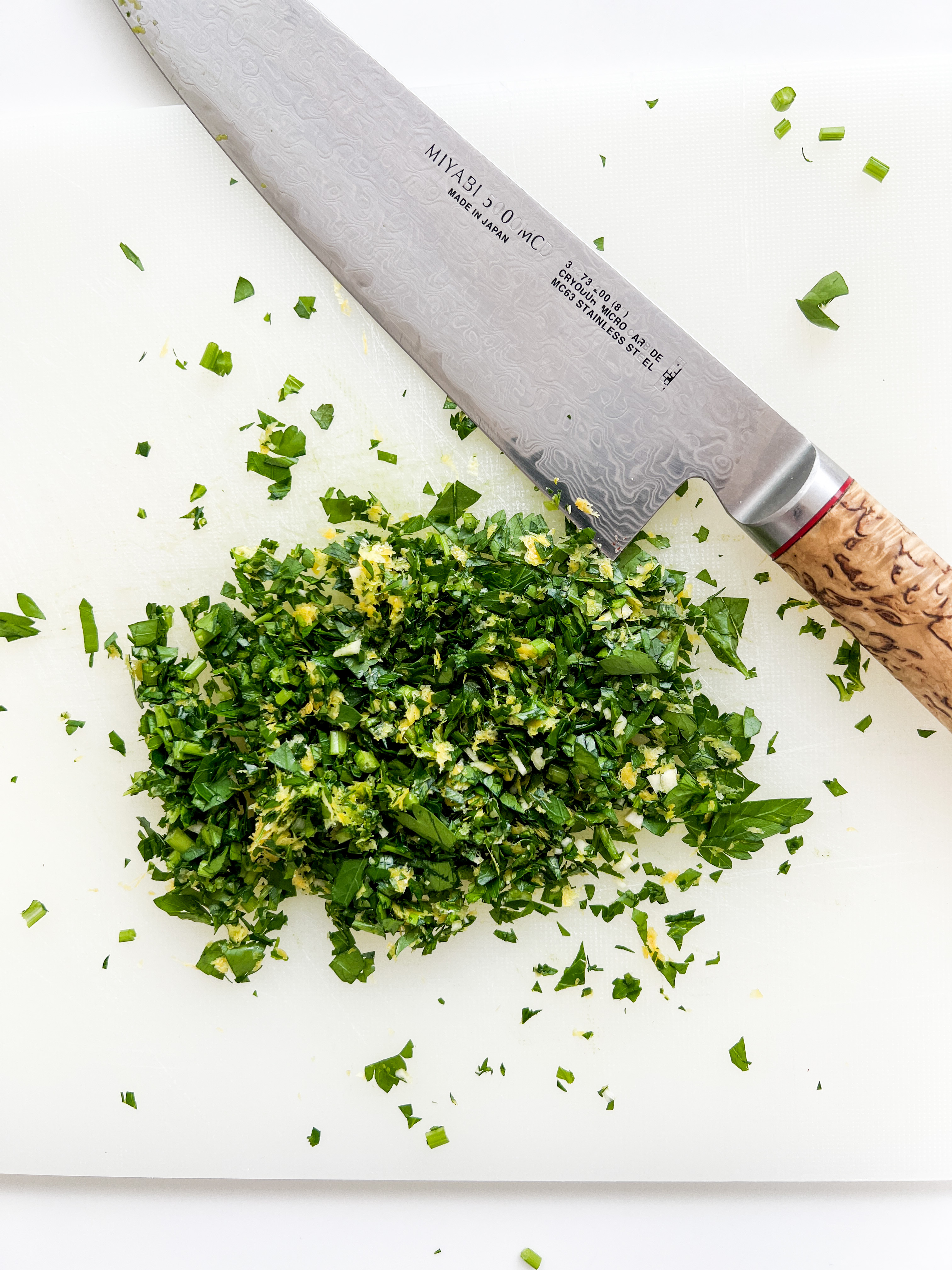
Finely chop
Finally, serve:
- I serve mine in one big serving dish, but you can do this individually too. Lay the melt-in-the-mouth veal shin on your risotto/polenta/potato.
- Drizzle with some sauce and sprinkle over the gremolata.
- Serve the rest of the sauce on the side with any remaining gremolata. It is delicious with some steamed green vegetables roast Mediterranean vegetables or a crispy green salad.
Made this recipe?
If you make this recipe, do please tag me on instagram @daffodil_kitchen. You could also leave a comment in the box directly below the recipe.
Osso Buco
At the heart and soul of Osso Buco are veal shanks, slow-braised to perfection in a rich broth infused with tomatoes and white wine. The shanks are cut on the bone from the veal’s shin. The marrow, cradled in this bone, is released into the stew during the slow-cooking process, imparting a deep, hearty flavour which helps define this traditional Northern Italian masterpiece. The resulting dish is indulgent, with fall-off-the-bone meat and a decadent sauce. To elevate this wonderful meal even further, Osso Buco is finished with a vibrant and zesty gremolata, adding a burst of freshness which beautifully balances the dish’s richness.
Ingredients
Meat:
- 4 veal shanks, trimmed and tied, around 5 cm thick and roughly 350g – 400g each
- 4 tablespoons plain/all-purpose flour
- ¼ teaspoon fine salt
- ¼ teaspoon freshly ground black pepper
- 2 – 4 tablespoons olive oil
Sauce:
- 2 tablespoons olive oil
- 200g – 250g/2 onions, diced into 1 – 1½ cm cubes
- 150g/2 – 3 carrots, diced into 1 – 1½ cm cubes
- 130g/2 stalks of celery, diced into 1 – 1½ cm cubes
- 2 bulbs of garlic, halved horizontally
- 500ml/2 cups of dry white wine
- 2 tablespoons plain/all-purpose flour
- ¼ teaspoon fine salt
- ¼ teaspoon freshly ground black pepper
- approx 1.5 litres/6 cups chicken stock
- 2 tablespoons tomato paste
- 2 sprigs fresh rosemary
- 2 sprigs fresh thyme
- 2 bay leaves
- 4 whole cloves
Gremolata:
- 20g fresh flat-leaf Italian parsley
- grated zest from 2 lemons
- 3-4g/1 clove of garlic
Serve:
- gremolata
- Risotto alla Milanese/mashed potatoes/creamy polenta/pasta. If you are looking for lighter options, try Cauliflower Purée, Celeriac Purée or a Celeriac and Potato Puree
- green salad or vegetables such as green beans or roast Mediterranean vegetables
Instructions
-
Collect together your equipment (see Recipe Notes below) and ingredients.
-
Start with the meat: measure the flour onto a mixing plate and season well with salt and freshly ground black pepper. Stir well to mix.
-
Dredge the veal in flour on both sides.
-
Measure 1 – 2 tablespoons oil into your oven proof casserole over a moderately high heat. When the oil is hot, put 1 or 2 shanks of veal into the pan and brown on both sides. Do not overcrowd the pan; cook them individually, if necessary. They take around 3 minutes per side. Repeat with the remaining veal, adding more oil as required.
-
Put 1 – 2 tablespoons oil in your oven proof casserole over a moderately high heat. When the oil is hot, shake excess flour off the veal, put 1 or 2 shanks into the pan and brown on both sides. Do not overcrowd the pan; cook them individually, if necessary. They take around 3 minutes per side. Repeat with the remaining veal, adding more oil as required.
-
Remove from the pan and cover with foil.
-
Next the sauce: NB You can cook this on the hob or in the oven. Your choice.
-
If cooking in the oven, preheat to 150°C/300°F/Gas 2 (fan 130°C).
-
Discard the oil from the pan and wipe out to remove any burnt flour. Add a further 1 tablespoon of oil, over a moderate heat. When the oil is hot, add the onion, carrot and celery (soffritto) and cook for 10 minutes, stirring from time to time, until soft and slightly caramelised.
-
Add the garlic and continue to cook for a further 2 minutes.
-
Now add the wine and cook until it has reduced and almost disappeared.
-
Add the flour, salt and pepper and stir well. Cook for 2 minutes. NB Do not add any more salt and pepper at this stage. When you reduce the sauce later, taste it and adjust the seasoning, if necessary.
-
Add the stock, tomato paste, rosemary, thyme, bay leaf and cloves and bring to a gentle boil, stirring all the time.
-
Turn down to a simmer and add the veal back to the pan. Make sure the veal is covered by the sauce, or at the very least, ¾ of the way up the side of the veal. If necessary, add extra stock. Cover and cook on very low, on the hob, for 2½ – 3 hours. Alternatively, cook in a preheated oven for the same length of time. NB Keep an eye on your stock levels. If necessary, add more stock.
-
When the veal is cooked i.e. very soft and falling off the bone, remove carefully from the pan and cut off the string/twine. You can serve it on or off the bone. I prefer mine served off the bone so I remove it, as well as any fat, before I serve.
-
Strain the sauce through a sieve into a different saucepan and return the veal to the casserole dish to keep warm.
-
Bring the sauce to the boil in the saucepan and continue to cook over a high heat until the sauce and is reduced. thick and glossy. Taste the sauce and adjust seasoning, if necessary. You need around 350ml of reduced sauce.
-
Return the sauce to the casserole dish and bring back to a gentle simmer to ensure the veal is piping hot.
-
The Gremolata: roughly chop the parsley and garlic and grate over the lemon zest.
-
Finely chop the parsley, lemon and garlic together.
-
Serve: I serve mine in one big serving dish, but you can do this individually too. Lay the veal on your risotto/polenta/potato.
-
Drizzle with some sauce and sprinkle over the gremolata.
-
Serve the rest of the sauce on the side with any remaining gremolata. It is delicious with some steamed green vegetables, roast Mediterranean vegetables or a crispy green salad.
Recipe Notes
Equipment:
- kitchen scales and measuring spoons
- chopping board and knife
- cast iron casserole – suitable for the hob and the oven, if necessary
- mixing bowl/plate
- saucepan
How classic is this recipe?
Like all traditional dishes, there is no single recipe. Occo Buco varies area to area and family to family. My version is based on a range of recipes I have tried and adjusted to suit our palate. Whilst I hope it stays true to the classic Milanese dish, cooking the meat on the bone but serving it off the bone, and straining the sauce, are the two most obvious divergences from most recipes. Happily, these are two changes you can easily ignore; however, if you choose not to strain your sauce, you will still need to reduce the liquid and don’t forget to remove the cooked herbs and garlic halves.
What should I serve with Osso Buco?
For a truly classical experience, Osso Buco is served with a side of Risotto alla Milanese, a golden-hued, saffron infused rice dish that perfectly complements this dreamy stew. Creamy Polenta is another classic accompaniment and mashed potatoes are also a fabulous match. If you are looking for lighter options, try Cauliflower Purée, Celeriac Purée or a Celeriac and Potato Purée.
You May Also Like
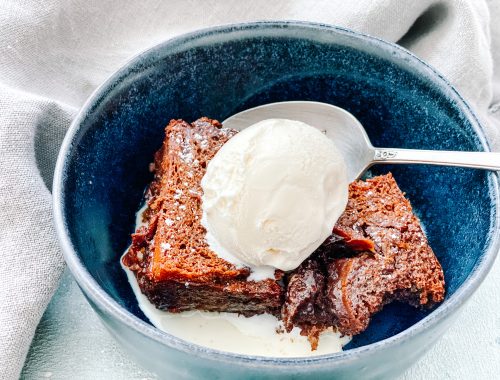
Chocolate Orange Bread and Butter Pudding
12th April 2021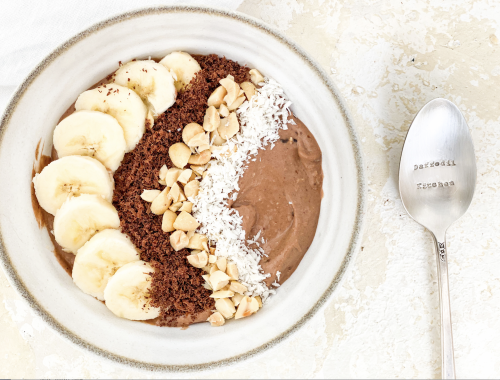
Chocolate, Banana, Peanut Smoothie Bowl with Peanut Butter and Date
11th July 2021